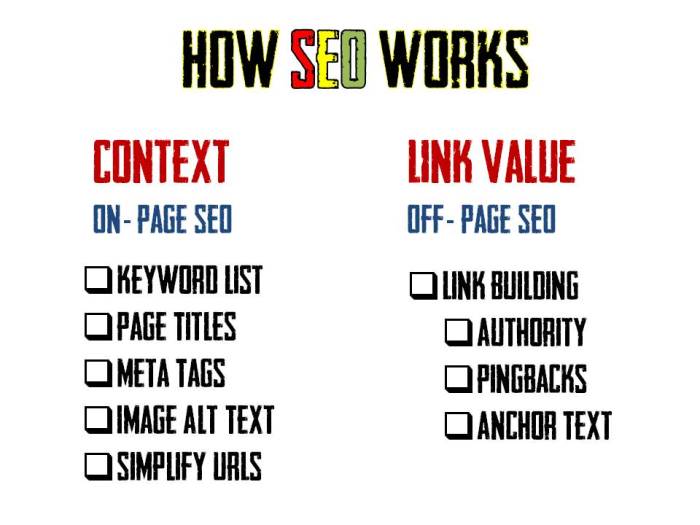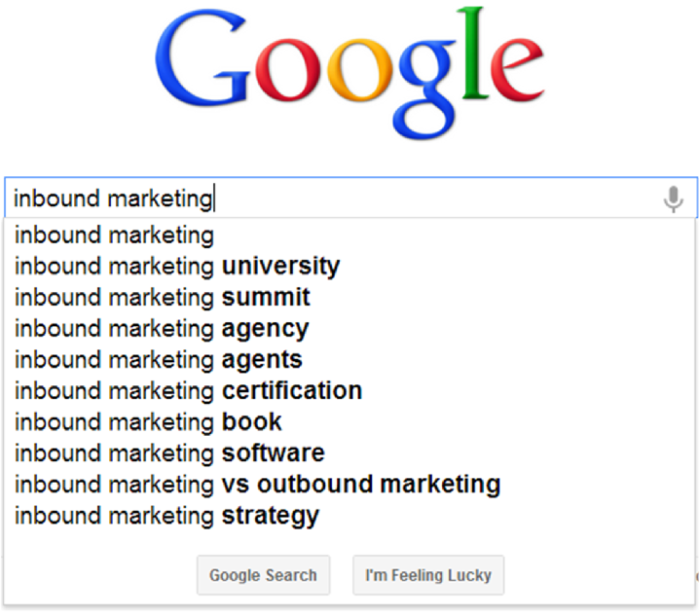Introduction – How SEO Works
SEO (Search Engine Optimization) is a necessary step to bring visitors to your website and to generate leads. Search engines exist to organize the clutter of the internet. When a search term is entered into Google, every relevant website is battling for user clicks and a higher PageRank. This post is intended to guide you through the process of implementing and understanding SEO practices and help get your website noticed by relevant prospects.
To start this journey, we must understand that search engines are driven by Context and Link Value.
Context
Context refers to your website’s overall search engine readiness, which helps Google rank your page for searchers. Ranking is based on the following attributes of a page:
On-page SEO
On-page SEO is everything inside of your website that signals to search engines what you’re page is about.
Stage 1: Develop a keyword list
Keywords are a list of words and phrases used to describe your business or website. Keyword research involves thinking like a prospect customer to determine common search terms. When developing your keyword list, consider:
- Overall search volume:
- Pick a search term that has enough people searching for that term (volume) that can bring visitors to your website.
- Keyword competition:
- Start with terms that you know you can rank #1. After you start ranking #1 for basic keywords, start competing for more keywords to get more and more traffic. Think of this process as a keyword war: the more you advance in the keyword “field”, the more “land” you occupy.
It is uncommon for people to continue onto the second page of Google search results. So, make it your goal to be on the first page for your top keyword terms.
Stage 2: Tools to help you keyword research:
SpyFu researches the keywords used by any website. This is a great tool to determine the competition for a keyword. Click the logo below to find out more:
SEOmoz helps with every stage of your SEO tasks. Click the logo below to find out more:
Stage 3: Page Titles
The page title suggests the topic of a page. It is the strongest signal that you can send to search engines. Place your primary keyword first, followed by your secondary keywords. Since you are going to rank for your brand name relatively easy, structure your titles like this: 
Example:
Never title your home page as “Home”. This is the ultimate sin in the world of SEO, because it doesn’t signal the context of your page to Google.
Stage 4: Meta descriptions
 Although SEO techniques will help you rank higher, it is ultimately a human who will be decide to click on a link or not. Use a balance of effective keywords and appealing descriptions. Consider your page description as important as a title of a chapter in a book, or a headline in a newspaper. You want to use relevant searched keywords, along with making it intriguing enough for someone to click on it.
Although SEO techniques will help you rank higher, it is ultimately a human who will be decide to click on a link or not. Use a balance of effective keywords and appealing descriptions. Consider your page description as important as a title of a chapter in a book, or a headline in a newspaper. You want to use relevant searched keywords, along with making it intriguing enough for someone to click on it.
Stage 5: Make use of meta tags
Make use of meta tags (e.g. <h1>, <p>) for headings and page content. When a visitor is skimming your blog post, headings visually organize your post for the reader. Search engines can’t see the visual layout of your website, but reads your source code instead. To help search engines understand what is a heading and a paragraph, you should organize your post using the appropriate meta tags.
Stage 6: Add image descriptions
 Unlike humans, search engines cannot see images. Search engines only read the source code. Make it easy for search engines to navigate your images by including keywords in the alt text of your source code. This alt text also appears when a visitor hovers over your image. To do this, add a clear description using relevant keywords in the alt text of your image. Below is the alt text of the image above:
Unlike humans, search engines cannot see images. Search engines only read the source code. Make it easy for search engines to navigate your images by including keywords in the alt text of your source code. This alt text also appears when a visitor hovers over your image. To do this, add a clear description using relevant keywords in the alt text of your image. Below is the alt text of the image above:
Stage 7: Simplify your URLs
As a search engine crawls a web page, it attempts to match searched terms with keywords in a URL, as well as other aspects on a page. Include your most important keywords in your URLs to make them keyword rich. If your page is about Irish sports, and your URL is in this format:  Change it to this:
Change it to this: 
Link Value
Off-page SEO
Off-page SEO is everything external of your website that signals to search engines the relevance of your page. Search engines award relevant websites SEO-credits during the ranking process:
Link building

This can range from contacting influential bloggers, to interviewing subject thought-leaders, or inviting guest bloggers to post on behalf of you. The entire purpose to this is to build your inbound links from their site to yours. These inbound links are valued based on a number of factors:
Authority
Authority is the amount of trust a search engine places on a particular webpage based on the traffic volume from linked site. It is defined by the number and power of inbound links coming to your webpage. A trustworthy site like Mashable that generates thousands of views per day would raise your SEO value an incredible amount, let alone increase your click through rate from Mashable. A smaller blogger with less of a following would increase your SEO value, but to a lesser degree.
No-follow or do-follow
This is information in the source code of a page to include the inbound link (called a pingback). If a search engine sees a no-follow attribute, it does not pass the SEO-credit for that link: meaning that link does not benefit anyone as it has no value. The purpose of this is to prevent black hat techniques such as link farming.
Anchor text
This is the underlined text that is clickable. It is similar to a hashtag in Twitter that signals a certain word is important.
Conclusion: How SEO (Organic) is a better investment than paid search
Search engine optimization is a long term investment that will always reward you. Paid search is a great way to promote your website initially to appear at the top of search results, but it is a short term investment. Once money has been invested in paid search, it is gone and will only give you a return on investment when a certain predefined number of impressions or clicks have been reached.
So, I hope that this post has convinced you to invest in organic search and has helped to provide you with the guidelines to start the process.
What’s next?
Do you need help with SEO for your company?
Are you looking for the next addition to your marketing team? I can help bring your company up-to-date with SEO and social media. If my knowledge and blogging skills have impressed you, click here to schedule an interview with me. If you would like to learn more about me, click here.
Where to learn more
I would highly recommend to invest in this book by the co-founders of HubSpot: “Inbound Marketing: Get Found Using Google, Social Media, and Blogs” by Brian Halligan and Dharmesh Shah. SEO is an integral step for getting found by prospect customers. If you would like to learn more, watch this video (SEO stuff starts at 10:44 to 17:27 minutes into the video).






